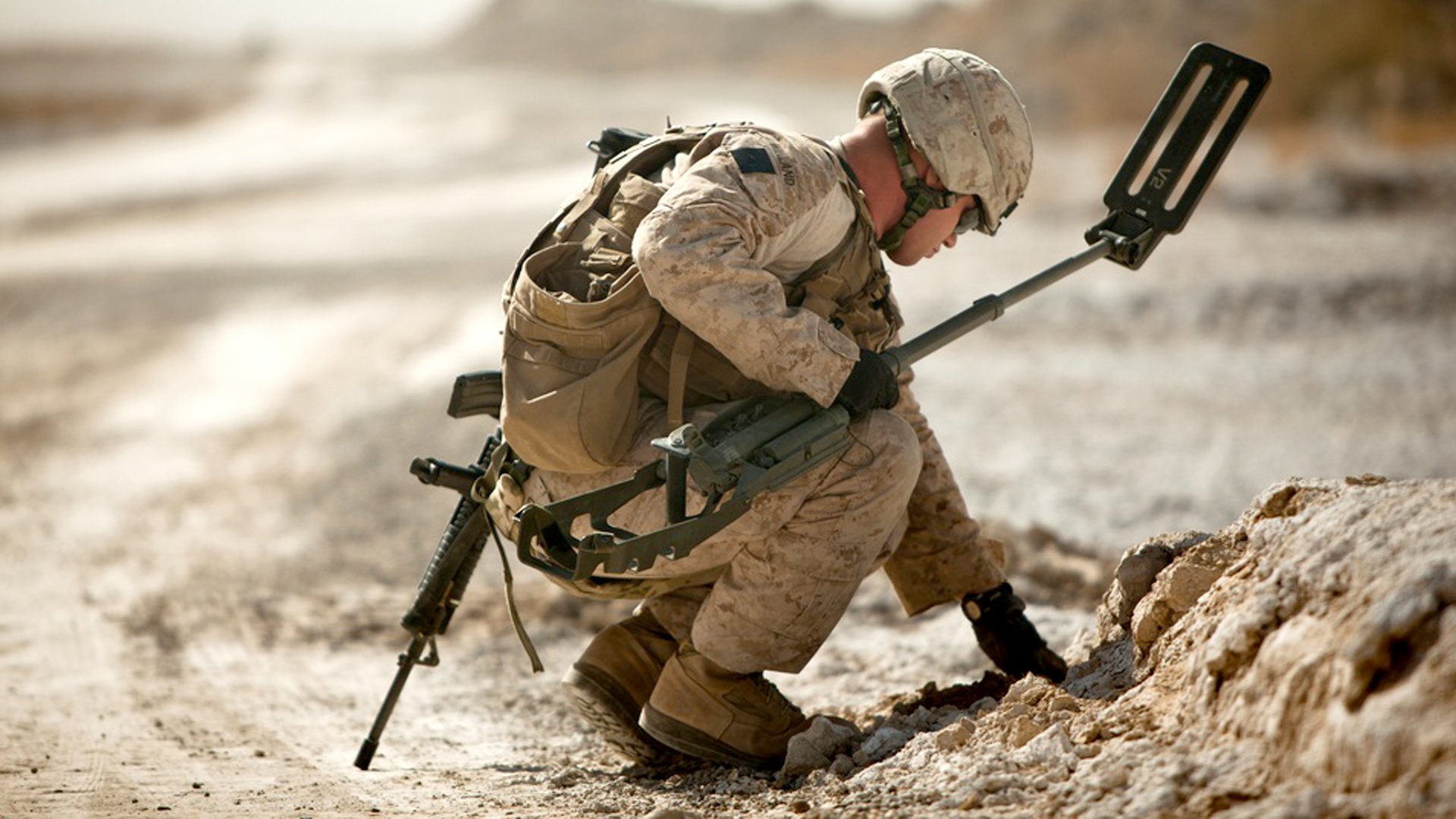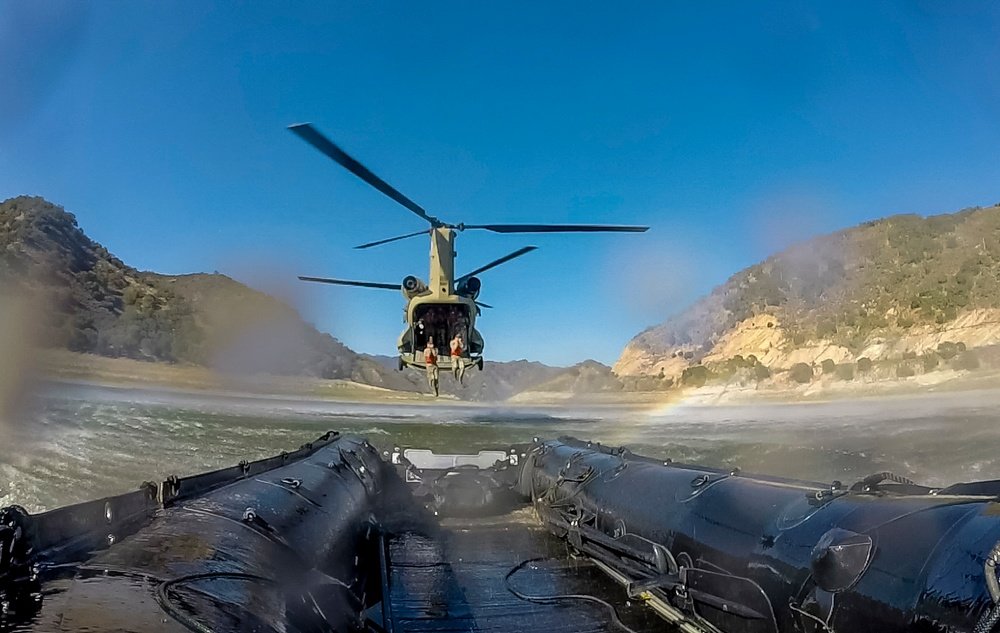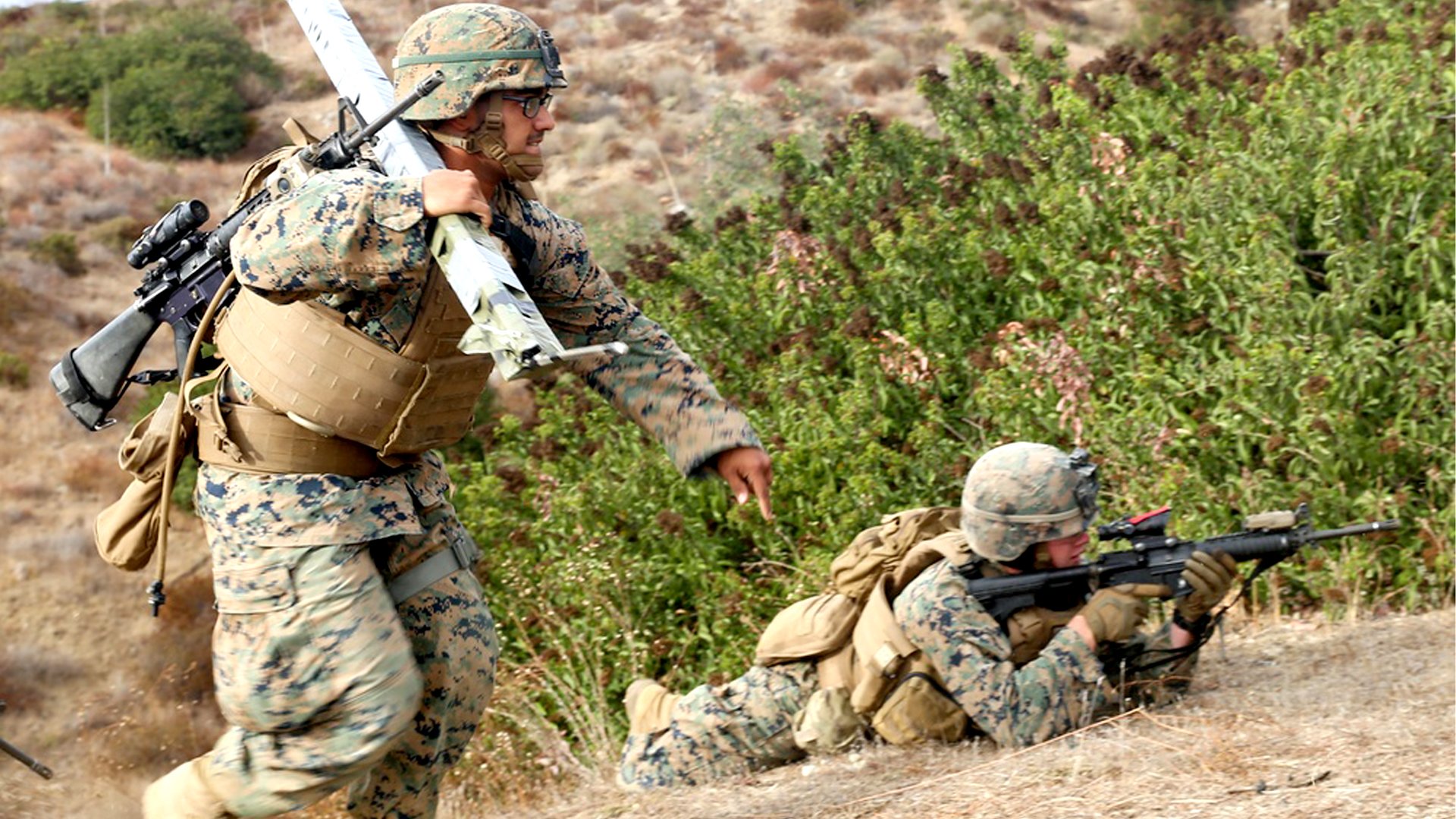
Lance Cpl. Bobby Winland, a combat engineer with Bridge Platoon, Alpha Company, 9th Engineer Support Battalion and a native of DeLeon Springs, Florida, checks for IEDs before his platoon can move in and begin construction on a bridge near Combat Outpost Rankel in the district of Garmsir, Helmand province, Jan. 29, 2012. US Marine Corps photo by Cpl. Brian Nygaard.
Marine combat engineer Lance Cpl. Arden Buenagua understood the risk he was taking when he extended his green, plastic metal detector and assumed the position at the head of the single-file patrol.
The grunts behind Buenagua were his friends. They followed in his footsteps as he walked the lonely road so often traveled by combat engineers, knowing, as he did, that if there were a hidden bomb waiting for them he’d probably be the one to trigger it. Every Marine who had walked point before Buenagua during his time in Sangin had either been killed or grievously wounded.
On Nov. 24, 2010, Buenagua stepped on an IED. The explosion killed him. Like so many other combat engineers killed in the line of duty, he died doing what he was trained and expected to do. He died leading the way.

Marine combat engineers move the nosepiece of a bridge into place in Mirmandab, Afghanistan, March 25, 2012. US Marine Corps photo by Cpl. Anthony Ward Jr.
What Does A Combat Engineer Do?
Combat engineers are among the most versatile, reliable, and misunderstood troops in the United States military. They possess a variety of skills that are crucial in war.
Both the Army and the Marine Corps turn to their combat engineers whenever they need something built. They can construct bridges capable of bearing the weight of entire armored units, defensive fortifications that can withstand complex enemy attacks, and berthings to house even the most forward-deployed troops. None of the forward operating bases or combat outposts that dotted the battlefields of the Global War on Terror would exist without the good work of combat engineers.
Combat engineers are also the go-to experts when enemy obstacles need to be cleared or destroyed. During the Gulf War, combat engineers cut paths through Saddam Hussein’s so-called “impenetrable barrier” — a wall of minefields, wire obstacles, and fire trenches along the Iraq-Kuwait border. Their quick work was praised by Gen. Norman Schwarzkopf, commander of all American forces during the invasion, who famously said, “They went through the first barrier like it was water.”

Combat engineers from across the 82nd Airborne Division train for the Best Sapper competition, Feb. 12, 2020, on Fort Bragg, North Carolina. US Army photo by Sgt. Cody D.J. Parsons.
Later, during Operation Iraqi Freedom, combat engineers were called on again to lead the way. Across the war’s urban battlefields, where IEDs posed the biggest threat to American troops, engineers were often tasked with conducting route clearance missions. In this role, engineers cleared paths for other soldiers, sailors, and Marines to follow on foot and in vehicles and engage the enemy without their movement being restricted by the additional risk of concealed bombs.
When they weren’t conducting route clearance, combat engineers deployed to the battlefields of the War on Terror often filled in as explosive disposal experts. Though every branch has their own specially trained explosive ordnance disposal technicians, IEDs were so ubiquitous in Iraq and Afghanistan that engineers were relied upon to use their knowledge of explosives to take on some of the workload.
Related: How the Special Operations Combat Medic Course Provides Real-World Training
Combat Engineers Are Nothing New
In addition to being experts in explosives, demolition, and construction, combat engineers are also trained warfighters. In fact, engineer-soldiers have been integral to armies since at least 1884 BC, when the Greeks used their famous giant wooden horse to infiltrate the city of Troy and deliver the deathblow that finally ended the 10-year Trojan War.

Two US Army Reserve combat engineer soldiers from the 374th Engineer Company (Sapper) cast from a CH-47 Chinook into Lopez Lake, California, during a two-week field exercise known as a Sapper Leader Course Prerequisite Training. US Army photo by Master Sgt. Michel Sauret.
In 332 BC, Alexander the Great’s engineers built siege towers to topple the Persian city of Tyre. During the First Jewish-Roman War, Roman engineers spent two months constructing a giant ramp in order to ascend a mountain and sack the fortress of Masada. Nearly 2,000 years later, British engineers tunneled across no-man’s land and set off a series of bombs underneath the German trenches. The detonations, which initiated the Battle of the Somme, were so massive that they remain among the largest non-nuclear explosions ever recorded.
While British engineers were perfecting their tunneling skills in World War I, German engineers were forming experimental units of combat engineers known as “pioneers.” Armed with explosives and flamethrowers, these pioneer units specialized in destroying enemy fighting positions. Other nations recognized their effectiveness and eventually followed suit.

Marine combat engineers rush toward an obstacle with a Bangalore during Sapper Leader Course, Oct 31, 2017. The Marines in the Sapper Leader Course conducted demolition training to familiarize themselves with explosive breaching and develop proficiency in mobility support to infantry units. US Marine Corps photo by Lance Cpl. Matthew Teutsch.
American pioneer units proved equally as effective in World War II as their World War I German counterparts. During the Battle of Tarawa in 1943, for example, a Marine pioneer unit led by Lt. Alexander Bonnyman did what naval gunfire, aerial bombardments, and the infantry had already tried and failed to do: He successfully cleared the island’s largest enemy bunker. Using demolition charges and flamethrowers, Bonnyman and his 21-man unit killed an estimated 150 enemy soldiers. Bonnyman — who was posthumously awarded the Medal of Honor — and eight other pioneers were also killed. The battle was filmed, marking the first time actions that resulted in the awarding of a Medal of Honor were caught on video.
Related: ‘Peaky Blinders’: Inside the Real World War I History That Made the Characters
Are Combat Engineers Elite?
Combat engineers are among the most valuable troops on any battlefield. They are prized by commanders for their unique expertise and versatility. The US Army and the US Marine Corps both have designated combat engineers — MOSs 12B and 1371, respectively. Both are eligible to attend the US Army’s elite Sapper Leader Course.
At Sapper school, soldiers and Marines learn skills such as minefield clearance, demolitions, and airfield construction. Graduates are authorized to wear the coveted Sapper tab on their uniform and rank among the most elite combat engineers in the world.

The coveted Sapper tab. US Army photo by Master Sgt. Michel Sauret.
Among those who have earned the Sapper tab are an even more elite coterie of combat engineers: 18C, or Special Forces Engineer Sergeant. These highly trained operators provide Special Forces teams with any and all engineering support, usually in extremely austere environments and without the aid of heavy equipment. They embody the ethos of doing more with less.
Whether one is a member of Special Forces, wears the Sapper tab, or simply holds the military occupational specialty of a combat engineer, there is no question that the soldiers and Marines who serve in this highly important — and often very dangerous — role are exceptional. Without troops like Buenagua to lead the way, there would be no clear path to victory.
Read Next: Living Legends: The Incredible True Stories Behind Three Iconic Photographs

Mac Caltrider is a senior staff writer for Coffee or Die Magazine. He served in the US Marine Corps and is a former police officer. Caltrider earned his bachelor’s degree in history and now reads anything he can get his hands on. He is also the creator of Pipes & Pages, a site intended to increase readership among enlisted troops. Caltrider spends most of his time reading, writing, and waging a one-man war against premature hair loss.
BRCC and Bad Moon Print Press team up for an exclusive, limited-edition T-shirt design!
BRCC partners with Team Room Design for an exclusive T-shirt release!
Thirty Seconds Out has partnered with BRCC for an exclusive shirt design invoking the God of Winter.
Lucas O'Hara of Grizzly Forge has teamed up with BRCC for a badass, exclusive Shirt Club T-shirt design featuring his most popular knife and tiomahawk.
Coffee or Die sits down with one of the graphic designers behind Black Rifle Coffee's signature look and vibe.
Biden will award the Medal of Honor to a Vietnam War Army helicopter pilot who risked his life to save a reconnaissance team from almost certain death.
Ever wonder how much Jack Mandaville would f*ck sh*t up if he went back in time? The American Revolution didn't even see him coming.
A nearly 200-year-old West Point time capsule that at first appeared to yield little more than dust contains hidden treasure, the US Military Academy said.












